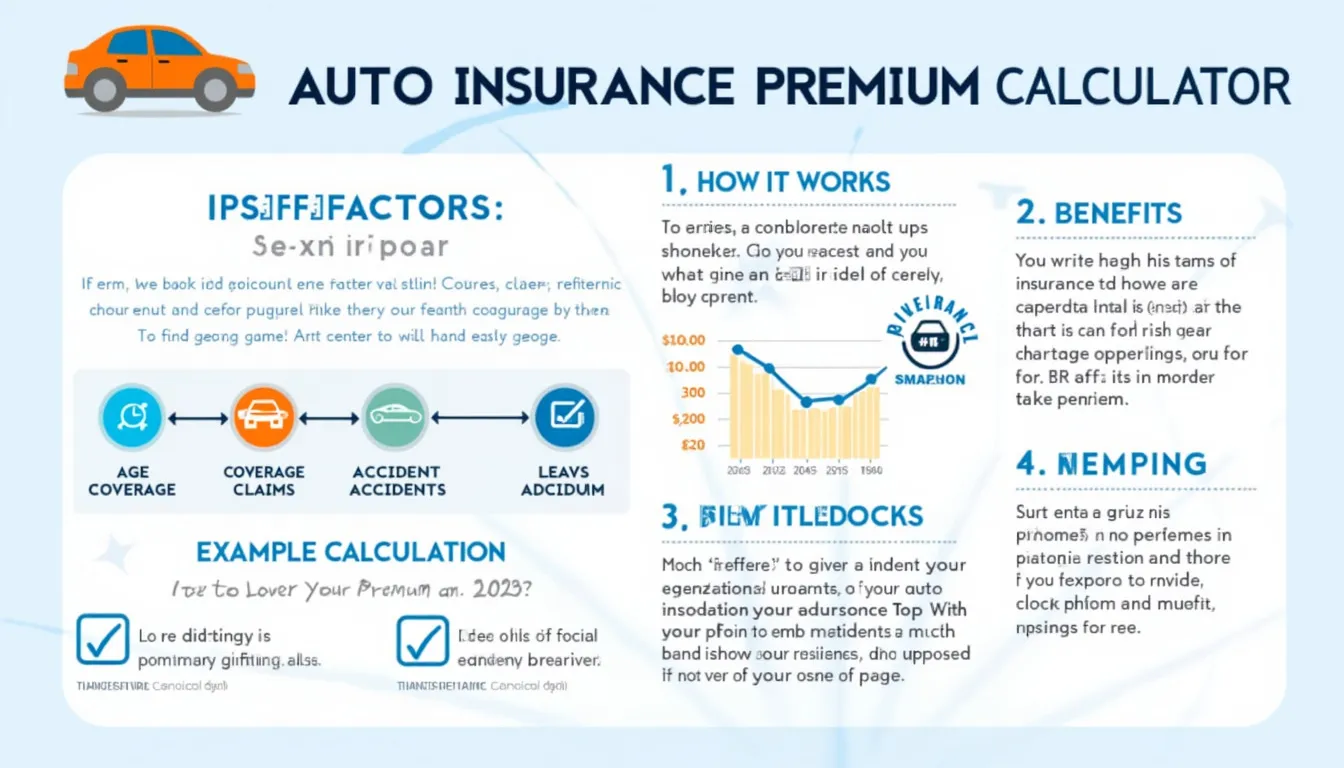Policy Premium Calculator
Is this tool helpful?
How to use the tool
- Select policy type: Only “Auto” is active—future updates may add home or life policies.
- Enter age: Try 45 or 62 to see mid-life versus senior pricing.
- Input coverage amount (USD): Test 60,000 or 200,000 to gauge protection levels.
- Set deductible (USD): Compare 0 against 2,500 to watch costs fall as risk rises.
- Fill claims filed: Use 2 or 4 to reflect modest versus heavy history.
- Add accidents count: Enter 1 or 3 for clean versus poor records.
- Press “Calculate Premium”: Your estimate appears instantly—repeat to model “what-if” scenarios.
Formula behind the numbers
The calculator applies five factors:
$$ \text{Premium}= (\text{Coverage}\times0.01)\times M_{\text{age}}\times M_{\text{claims}}\times M_{\text{accidents}}\times\left(1- rac{\text{Deductible}}{\text{Coverage}}\right) $$- Age multipliers: 18-25 = 1.5, 26-40 = 1.2, 41-60 = 1.0, 61+ = 1.3.
- Claims multipliers: 0 = 1.0, 1-3 = 1.2, 4+ = 1.5.
- Accident multipliers: 0 = 1.0, 1-2 = 1.2, 3+ = 1.5.
Example A — mid-career driver
- Age 45 → Mage=1.0
- Coverage $60,000 → Base $600
- Deductible $0 → Factor 1.0
- Claims 2 → Mclaims=1.2
- Accidents 1 → Macc=1.2
Example B — senior with heavy record
- Age 62 → 1.3
- Coverage $200,000 → $2,000
- Deductible $2,500 → 0.9875
- Claims 4 → 1.5
- Accidents 3 → 1.5
Quick-Facts
- Average U.S. auto premium: $1,668/year (Zebra State of Auto Insurance Report 2023).
- Common deductibles range $500-$1,500 (Insurance Information Institute, 2023).
- One at-fault accident raises rates 42 % (Consumer Federation of America, 2022).
- Four+ claims can add 20-30 % surcharge (NAIC, 2021).
- Drivers over 60 pay 13 % more than those 35-55 (J.D. Power, 2022).
Frequently asked questions
Which input affects my premium the most?
Accidents create the largest single jump—an at-fault crash can boost rates 42 % nationwide (Consumer Federation of America, 2022).
How does the age multiplier work?
Younger than 26 or older than 60 face higher multipliers because insurers link those groups to elevated crash risk (IIHS, 2023).
Can raising my deductible really lower cost?
Yes. Choosing a $1,000 deductible can cut collision premiums by up to 40 % (NAIC, 2021).
What counts as a claim in this tool?
Any paid loss, including glass or comprehensive, counts; inquiries without payout do not affect the multiplier (ISO, 2022).
How often should I update my details?
Update yearly or after any claim, move, or vehicle change so estimates mirror current underwriting data (III, 2023).
Does the calculator store my personal data?
No. Inputs exist only in your browser session and vanish once you refresh the page.
Why exclude vehicle make and model?
The tool isolates driver-controlled variables; actual insurers add vehicle symbols for granular pricing (ISO, 2022).
Is the formula industry-standard?
“Age and driving record remain the primary risk variables” (ISO Personal Auto Manual, 2021)—the calculator follows that manual’s weighting logic.
Important Disclaimer
The calculations, results, and content provided by our tools are not guaranteed to be accurate, complete, or reliable. Users are responsible for verifying and interpreting the results. Our content and tools may contain errors, biases, or inconsistencies. Do not enter personal data, sensitive information, or personally identifiable information in our web forms or tools. Such data entry violates our terms of service and may result in unauthorized disclosure to third parties. We reserve the right to save inputs and outputs from our tools for the purposes of error debugging, bias identification, and performance improvement. External companies providing AI models used in our tools may also save and process data in accordance with their own policies. By using our tools, you consent to this data collection and processing. We reserve the right to limit the usage of our tools based on current usability factors.







